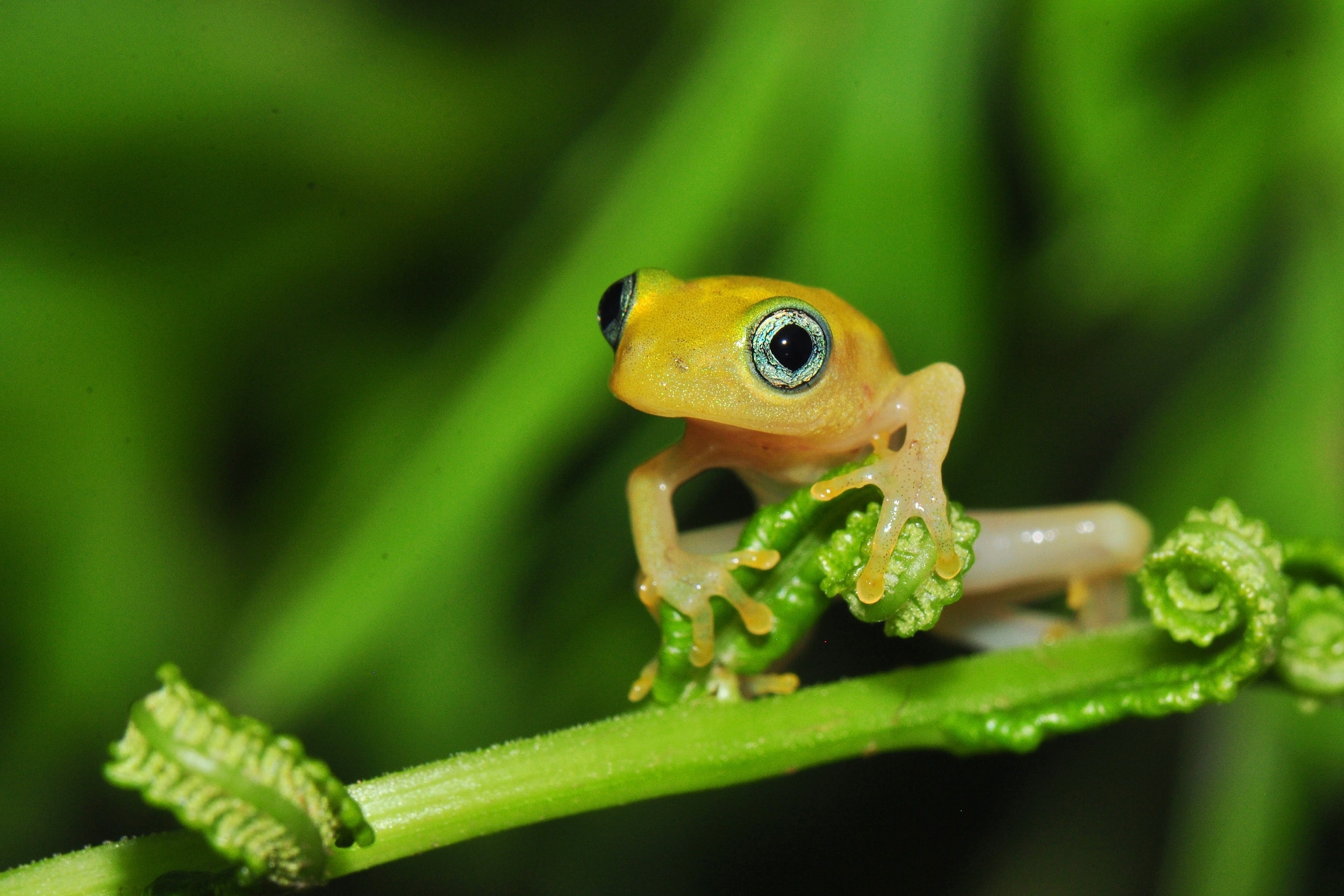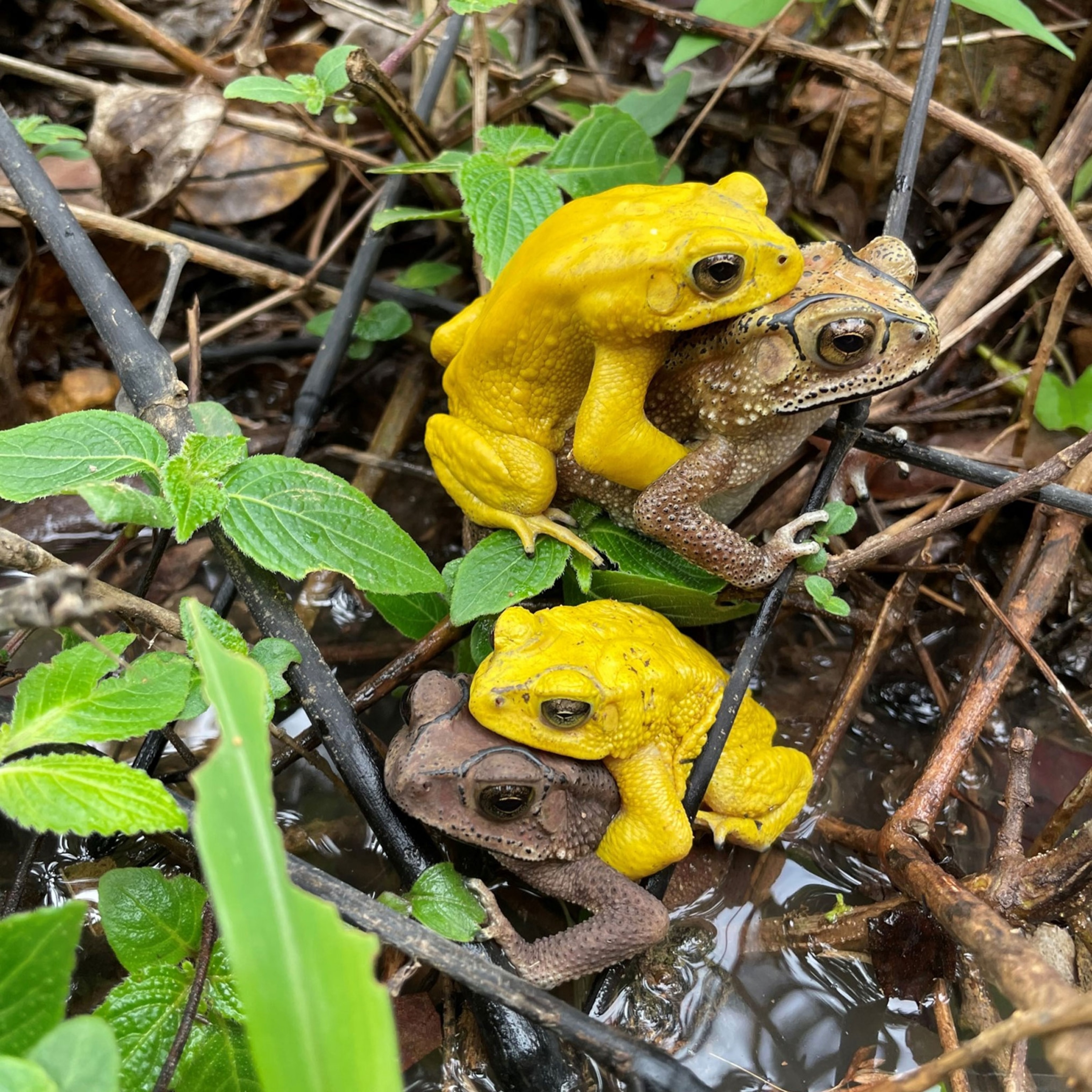For decades, a silent killer has slaughtered frogs and salamanders around the world by eating their skins alive. Now, a global team of 41 scientists has announced that the pathogen—which humans unwittingly spread around the world—has damaged global biodiversity more than any other disease ever recorded.
The new study, published in Science on Thursday, is the first comprehensive tally of the damage done by the chytrid fungi Batrachochytrium dendrobatidis (Bd) and Batrachochytrium salamandrivorans (Bsal). In all, the fungi have driven the declines of at least 501 amphibian species, or about one out of every 16 known to science.
Of the chytrid-stricken species, 90 have gone extinct or are presumed extinct in the wild. Another 124 species have declined in number by more than 90 percent. All but one of the 501 declines was caused by Bd.
“We’ve known that's chytrid's really bad, but we didn't know how bad it was, and it's much worse than the previous early estimates,” says study leader Ben Scheele, an ecologist at Australian National University. “Our new results put it on the same scale, in terms of damage to biodiversity, as rats, cats, and [other] invasive species.”
Scheele has seen the fungus's carnage firsthand. At one of his field sites in Australia, an extended El Niño fueled mass frog breeding and dispersal—letting Bd spread as never before. Before the fungus, populations of the alpine tree frog were so abundant there, he had to watch his step when he went out at night. Now, the species is nearly impossible to find.
Saddened and shocked, Scheele resolved to put numbers to the decline. Four years—and innumerable email conversations—later, Scheele's team has finally combined all known reports of chytrid declines into a single consistent database, revealing Bd and Bsal's record-breaking toll.
“Chytrid fungus is the most destructive pathogen ever described by science—that's a pretty shocking realization,” adds Wendy Palen, a biologist at Simon Fraser University in British Columbia who wrote about the study for Science.

The bulk of amphibian die-offs occurred in the 1980s—when the disease began to circulate around the globe—with a second uptick in mortality in South America in the mid-2000s. Many the affected frogs live in Central and South America, though outbreaks also occur across Europe, North America, Australia, and Africa. There are no known declines from Asia, where the fungus has co-existed for millions of years.
What's more, the study's counts are conservative. Earlier die-offs from the 1950s and 1960s in Europe and North America aren't included for lack of evidence. And the 501 species tallied are just the ones that scientists know about. Researchers keep identifying new species of frogs—even after they've been nearly wiped out in the wild.
The study's authors hope that the new research will act as a call to arms against the pandemic.
“I can totally understand why some people might see this issue as too little, too late, but I strongly disagree with that, because saying that does not truly take into consideration how much worse it can still get,” says study co-author Jonathan Kolby, a National Geographic Explorer and policy specialist at the U.S. Fish and Wildlife Service.
That's why researchers are urging governments around the world to buy amphibians time by curbing the trade of wild amphibians, protecting amphibian habitats, combating invasive species that threaten amphibians, and supporting captive-breeding programs.
Origins of a killer
There are hundreds of species of chytrid fungi, and most of them are unobtrusive decomposers. But Bd is an oddball: It has a fanatical taste for the proteins in amphibian skin. In the early 20th century, human activity—such as trade and war—accidentally spread the fungus around the world.
Along the way, it evolved, spawning a highly virulent strain that's primarily responsible for the pandemic.
Some amphibians can tolerate Bd, but in many others, it degrades the animals' permeable skin, which they use to breathe and regulate their water levels. Runaway infections trigger a death spiral that ends in cardiac arrest.

Not only is Bd lethal, it's also devastatingly effective at spreading. While most pathogens target specific hosts, Bd can infect at least 695 species to varying degrees. It also doesn't kill its victims quickly, which increases the odds that the fungus will spread. Species it doesn't kill, such as the American bullfrog, can act as reservoirs.
In addition, the fungus can spread by touch or by water; Bd spores can swim a short distance. And if conditions are right, the fungus can live outside of its host for weeks to months—maybe even years—at a time. “In some respects, it’s the perfect pandemic recipe,” says biologist Dan Greenberg, a Ph.D. student at Simon Fraser University. “If it were a human pathogen, it'd be in a zombie film.”
As National Geographic has previously reported, Bd snuck up on researchers much like a fictional zombie plague. Scientists first started noticing frog die-offs in the 1970s, but researchers didn't realize these “enigmatic declines” were a global phenomenon until the 1990s. Researchers described Bd in 1997; within a decade, it was the top suspect in the killings.
Study co-author Karen Lips, an ecologist at the University of Maryland, watched as the fungus spread through sites she had been monitoring for more than 15 years. From 2004 to 2008, one of her sites in Panama lost more than two fifths of its amphibian species to Bd. “You get to know this system, and it’s all completely wiped out,” she says. “It’s just horrible to see that degree of change.”
Similar scenes played out in the French Pyrenees, where midwife toads keel over by the hundreds on mountain lake shores. “Early in the outbreak, midwife toads would be calling at full volume—it’s a beautiful chorus. Once the disease has swept through, you don't hear any calling,” adds study co-author Mat Fisher, an epidemiologist at Imperial College London. “The world becomes very quiet.”
Holding the line
Researchers say that we can't reverse the damage that Bd has already done. The fungus is already worldwide, and purging it from the environment is impossible. While topical fungicides can heal Bd-stricken amphibians in the wild, they can't be applied on a global scale.
In the face of this reality, the study's authors say our best bet is to greatly curtail the global trade of wild amphibians, or at the very least improve screening procedures. The pet and meat trades probably play a major role in continuing the pathogen's spread. A 2018 study confirmed that all major strains of Bd, including the one most responsible for the global pandemic, are present in pet-shop animals.

Despite its impact, the fungus hasn't attracted the same attention as wildlife diseases such as white-nose syndrome, a fungal disease that infects bats.
“If you look at the number of species impacted, [white-nose syndrome] is so incredibly dwarfed by the number of amphibians—and then you look at the levels of effort and funding and attention,” says Kolby. “Why aren’t we giving that much attention to the frogs?”
U.S. officials are monitoring the situation, but because Bd is already widespread in the United States, there's only so much they can do. But researchers have pointed out that Bd consists of many different lineages. One 2011 study suggested that BdGPL, the deadliest strain of all, emerged when separate Bd strains hybridized.
“If we stop trying to emphasize the importance of biosecurity, disease control, and disease surveillance at the government level, it's hard to think that we're not going to have another hybrid event,” says Kolby. “That would start everything all over again: a new strain, with new virulence. That's what I find scary.”
The U.S. has room to take a more proactive approach to Bsal, which has ravaged salamanders in Europe but hasn't yet been detected in the U.S., a global haven for salamander biodiversity. In 2015, U.S. government agencies formed a task force expressly focused on Bsal. In 2016, U.S. officials moved to ban the import of 201 salamander species.
The U.S. is hardly alone in the fight against Bd; officials around the world are working to curb the fungus. Scientists have set up regional networks to track the fungi's spread, and the World Organization for Animal Health (OIE)—the non-human equivalent of the World Health Organization—has issued recommendations for how to trade amphibian products while minimizing the risk of spreading Bd. In 2015, the OIE and CITES, the treaty that oversees the global wildlife trade, signed an agreement to work more closely together.
Even now, some species stand a chance of evolving resistance to Bd and Bsal. Of the 292 chytrid-stricken species that have survived, 60 show some signs of recovery.
To buy critical time, Scheele says, the world needs to lessen the other threats amphibians face, from habitat loss to invasive species. In addition, captive-breeding efforts such as the Amphibian Ark could act as genetic lifeboats.
But Palen notes that the basic remedies have been known for decades: “It's pretty sobering that we haven’t been able to do those sorts of obvious things,” she says. “Maybe this is a real wake-up call.”








